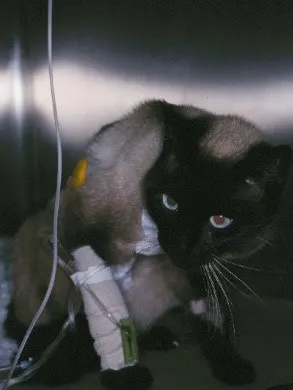Grapiprant or Carprofen for Postovariohysterectomy Analgesia in Cats?
Rebecca A. Johnson, DVM, PhD, DACVAA, University of Wisconsin

In the Literature
Teixeira LG, Vaccarin CV, Schimites PI, et al. Grapiprant or carprofen following ovariohysterectomy in the cat: analgesic efficacy, hematological, biochemical and urinalysis evaluation. J Feline Med Surg. 2022;24(8):e153-e162. doi:10.1177/1098612X221097935
The Research ...
Preoperative oral analgesics can help manage intra- and postoperative analgesic requirements. Carprofen (an NSAID that preferentially inhibits the COX-2 enzyme and thus prostaglandin E2 synthesis) and grapiprant (a specific antagonist of the prostaglandin E2 receptor EP4) can be administered orally but are considered extra-label in cats.1 Both drugs are FDA-approved for use in dogs.
This study compared effects of carprofen (4 mg/kg PO once) and grapiprant (2 mg/kg PO once or every 12 hours) when initially administered 90 minutes prior to ovariohysterectomy in cats. Analgesic effects were assessed at baseline and at 1-, 3-, 6-, 8-, 12-, and 24-hours postoperatively using validated and moderately validated pain scoring systems with set intervention levels for rescue analgesia (morphine, 0.1 mg/kg IV).1-3 Hematologic, biochemical, and urinalysis variables and urine protein:creatinine ratio were also evaluated.

Cat displaying signs (eg, rigid sitting position with back arched, head down, muzzle and whiskers pulled ventrally, anxious appearance) included in validated pain scoring systems.2,3
Photo courtesy of Lesley Smith, DVM, DACVAA
Pain scores did not significantly differ among treatment groups (ie, carprofen once, grapiprant once, grapiprant every 12 hours), and scores at 3 hours after surgery were higher than scores at 24 hours in all groups. Significantly more cats required rescue analgesia in both grapiprant groups (14 out of 21 cats [67%]) compared with the carprofen group (2 out of 11 cats [18%]). Glucose increased from baseline at 1 hour in both grapiprant groups. No other variables differed among the groups. Leukocytosis, presumably associated with inflammation, was noted 12 hours postoperatively in all groups. Grapiprant administered every 12 hours did not result in observed benefits.
These results suggest oral grapiprant administration prior to ovariohysterectomy did not provide adequate postoperative analgesia at 3 hours in cats. Preliminary investigations in dogs indicated grapiprant may be comparable with carprofen for analgesia following ovariohysterectomy, but sample sizes were limited, and further studies are necessary.4
Although results suggest carprofen may be preferrable to grapiprant for acute postoperative pain in cats, 2 out of 11 cats in the carprofen group required rescue analgesia, indicating carprofen alone may also be inadequate postoperatively in cats, including after ovariohysterectomy. Multimodal pain management is thus highly recommended; pre-emptive or preventive analgesia, continuous and overlapping pharmacologic and nonpharmacologic therapies (including agents with different mechanisms of action), and matching the analgesic plan to the degree of injury or surgery should be considered.1
... The Takeaways
Key pearls to put into practice:
Grapiprant (2 mg/kg PO) administered 90 minutes prior to ovariohysterectomy did not provide adequate analgesia in most cats 3 hours postoperatively and was associated with acute increases in systemic glucose for up to 1 hour.
Neither oral grapiprant nor carprofen altered important hematologic variables (eg, platelet numbers, indirect markers of acute kidney or liver dysfunction).
Grapiprant alone should not be used for postovariohysterectomy analgesia in cats but may be useful as part of a pre-emptive, multimodal analgesic plan for surgery, especially if additional chronic pain is expected.